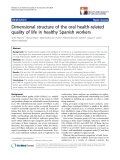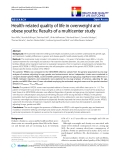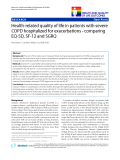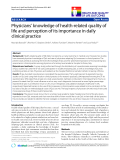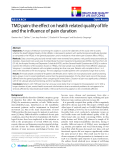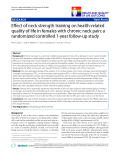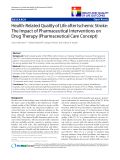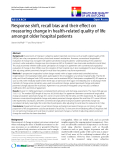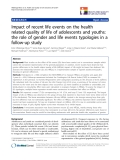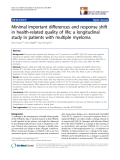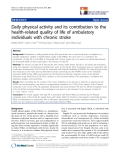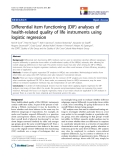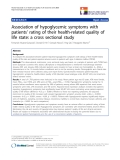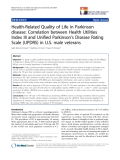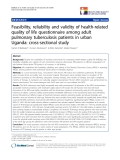
79
Journal of Medicine and Pharmacy, Volume 13, No.04, June-2023
Assessment of health-related quality of life among outpatients with
asthma at Hue University of Medicine and Pharmacy Hospital
Vo Thi Hong Phuong1, Nguyen Thi Ngoc Quyen1, Ngo Thi Kim Cuc1,
Phan Dang Thuc Anh1, Hoang Thi Lan Huong2, Nguyen Phuoc Bich Ngoc1*
(1) University of Medicine and Pharmacy, Hue University
(2) Thua Thien Hue Department of Health
Abstract
Background: Asthma is either a chronic respiratory disease or a serious global health problem that is common
in all ages at a high rate. It seriously affects not only the physical health but also the health-related quality of life
(HRQoL) of patients. Objectives: (1) To determine HRQoL score among asthmatic outpatients at Hue University
of Medicine and Pharmacy Hospital; (2) To assess factors associated with HRQoL among asthmatic outpatients
at Hue University of Medicine and Pharmacy Hospital. Subjects and methods: A descriptive cross-sectional
study was conducted on 102 asthmatic outpatients at Hue University of Medicine and Pharmacy Hospital by
using a self-administered questionnaire. Results: The male-to-female patient ratio was 1.68/1. The mean age
of study participants was 59.2 ± 15.39 (26-95). A large number of patients were unemployed (55.9%) and had
a low education level (54.9%). Participants with comorbidities and time of being diagnosed with asthma over
10 years accounted for the highest percentage, 69.6%, and 48.0% respectively, but most patients were not
hospitalized due to an acute asthma attack within the past year (88.2%). The most common type of inhaler
being used was DPI or the combination of MDI and DPI (35.3%) whereas the prevalence of patients only using
the Metered-Dose Inhalers (MDI) was 29.4%. There were 40.2% of patients who were severely affected. The
mean value of the total HRQoL score was 4.27 ± 0.747. The domain that most impacted HRQoL was “Activity
limitations” whereas “Symptoms” affected the least. Men had higher HRQoL than women (6.441 times); The
participants who did not have asthma-related family history were likely to have better HRQoL than others (3.3
times); The patients who used MDI or DPI alone had higher HRQoL scores than the group used the combination
of two devices (2.788 times). Conclusions: Asthma remarkably affected asthmatic patients’ quality of life. The
factors associated with HRQoL were gender, family history of asthma, and the type of inhaler.
Keywords: Asthma, Health-related Quality of life, Outpatients, Hue University of Medicine and Pharmacy
Hospital.
1. INTRODUCTION
Asthma is a serious global health problem that
is common in all ages at a high rate. This medical
condition seriously affects 1-18% of the total
population worldwide and exerts a significant burden
not only on patients but also on their families [1].
According to the World Health Organization, most
asthma-related deaths occur in low- and middle-
income countries where diagnosis and treatment
remain suboptimal [2]. In Vietnam, the prevalence
of asthma is about 3.9% of the population (children
aged 13-14 years accounted for 14.8%) which is
equal to approximately 4 million asthmatic patients.
Additionally, an estimated 3000-4000 people have
died due to asthma each year [3].
Medical care for this condition has greatly
improved in recent years thanks to advances in
diagnosis, drug therapy, and non-pharmacological
treatments [4]. However, many studies have shown
that treatment objectives have not been met. The
fact that the number of patients with uncontrolled
or poorly controlled asthma is still high leads to
negative impacts not only on treatment costs
but also on the patient’s quality of life [5]. The
quality scores measured in asthmatic patients
were significantly lower than in healthy subjects.
In adults, asthma reduces working capacity, limits
a lot of physical and social activities as well as
influences sleep. The disease also affects children’s
development and reduces academic performance.
Up to 40% of children are absent from school due
to an acute asthma attack [6],[7]. Good asthma
control and improving the quality of life of asthmatic
patients are considered important and long-term
goals in the strategies for asthma management
and prevention of the “Global Initiative on Asthma”
Organization (GINA) as well as the Vietnam Ministry
of Health [1],[8]. Nowadays, studies on the quality
Corresponding author: Nguyen Phuoc Bich Ngoc, email: npbngoc@huemed-univ.edu.vn
Recieved: 22/2/2023; Accepted: 4/5/2023; Published: 10/6/2023









